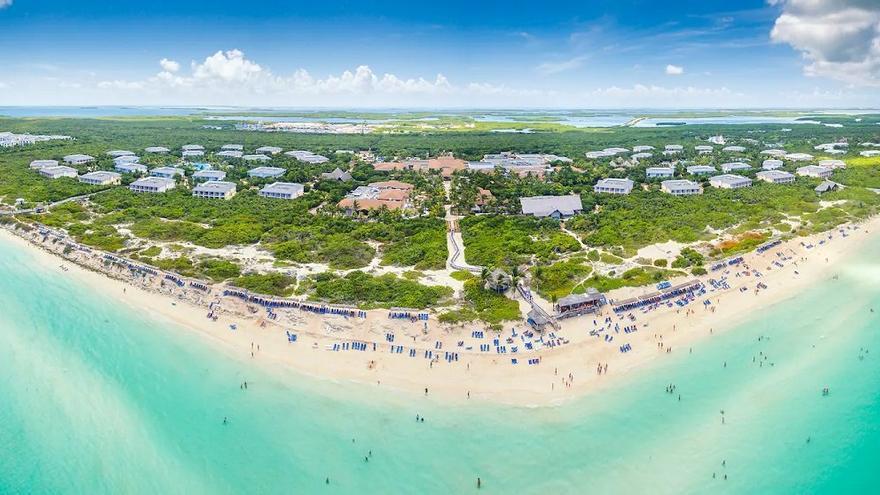
![]() 14ymedio, Madrid, September 26, 2023 — The Spanish hotel company Meliá received favorable attention from the official Cuban press on Monday. Reproducing a statement from the company itself on the occasion of the International Day for the Preservation of the Ozone Layer, on September 16, the Prensa Latina agency highlighted that “several of the facilities” of the chain on the Island “are free of harmful substances” for the atmosphere.
14ymedio, Madrid, September 26, 2023 — The Spanish hotel company Meliá received favorable attention from the official Cuban press on Monday. Reproducing a statement from the company itself on the occasion of the International Day for the Preservation of the Ozone Layer, on September 16, the Prensa Latina agency highlighted that “several of the facilities” of the chain on the Island “are free of harmful substances” for the atmosphere.
This is the case of the Meliá Internacional Varadero, Meliá Varadero and Meliá Las Américas, in the Matanzas peninsula, and Meliá Buenavista, Meliá Cayo Santa María and Sol Cayo Santa María, in Villa Clara. All of them, the article mentions, received the corresponding recognition from the Cuban Ministry of Science, Technology and Environment.
The “new certifications” continue, joining those already held by the Paradisus Los Cayos and Meliá Las Dunas hotels, in Cayo Santa María; Sol Varadero Beach, in Matanzas, and Sol Río de Luna y Mares, on the north coast of Holguín.
“It is curious that the Government speaks in these terms, when it has always done very little to protect the environment of the large hotels of the Keys”
The official agency, in three complimentary paragraphs, insist on the same idea: that Meliá has a corporate strategy for the protection of the environment.
“It is curious that the Government speaks in these terms, when it has always done very little to protect the environment of the large hotels of the Keys,” says a specialist who collaborated in the late 90s and early 2000s with the Institute of Ecology and Systematics so that the construction of tourist infrastructure in the Keys of Ciego de Ávila and those of Villa Clara did not affect the environment as the others were doing.
For example, says the same specialist, who requests anonymity, “there was a small team that went to Cayo Guillermo and discovered that the construction of a local airport had devastated not only an archaeological site of the Siboney Indians, but also the entire area where the flamingos
nested.” After “a lot of noise and a report,” the specialists managed to get the Academy of Sciences to press for legislation on archaeological and natural heritage. “It even earned those involved a stimulus of 40 CUC [Cuban Convertible pesos, a currency no longer used], but like so many things in this country, it was just a piece of paper. The heritage continues to be destroyed.”
In just under three months, a new Law for the Protection of Cultural and Natural Heritage will come into force on the Island, with the aim of strengthening the preservation of protected sites. “It will be another decree that will not be complied with,” the specialist predicts. “Since the construction of the first causeway – an artificial road erected on stones to connect the island and the beaches of Los Cayos – there have been teams and more teams of scientists, sent by the commissions in collusion with those who direct the construction projects. Lots of reports have been written with numerous recommendations, just for the fun of it.
In just under three months, precisely, a new Law for the Protection of Cultural and Natural Heritage will come into force on the Island
He gives as an example the first causeway to Cayo Santa María: “A well-known botanist complained that the construction rules to maintain the marine flow from one side of the road to the other, through ducts beneath the causeway, were not being complied with. By violating this, the salinity of the sea on the coast of the Ciego de Ávila area increased, harming the mangroves and all the life that depended on it, including the fishing economy. In the town of Punta Alegre, it even affected the fishing cooperative.”
On top of this, he concludes, the violation of these rules not only generates “very big expenses because the road is always under repair,” but it is also “very dangerous”: “Once we got a downpour going over the causeway, and we had to stop the car because we thought we would end up overturned in the water, something that has happened to a few drivers.”
He also dedicated an official press release in Punta Alegre, in Ciego de Ávila, on Monday. Specifically, a group of 30 pink flamingos were “rehabilitated” in the mangrove thanks to the “international project” Coastal Resilience, which has the “accompaniment” of the United Nations development program in Cuba and funding from the European Union through the “Global Alliance for Climate Change Plus.”
According to Invasor, the ecosystem had been damaged not by tourism but by Hurricane Irma, in 2017. “Look,” says the same source. “The poor flamingos that were in Cayo Santa María and Cayo Las Brujas have been disappearing. They migrate and no longer return because the hotels and the constant repair of the causeway are displacing them and killing their food.”
Translated by Regina Anavy
____________
COLLABORATE WITH OUR WORK: The 14ymedio team is committed to practicing serious journalism that reflects Cuba’s reality in all its depth. Thank you for joining us on this long journey. We invite you to continue supporting us by becoming a member of 14ymedio now. Together we can continue transforming journalism in Cuba.
